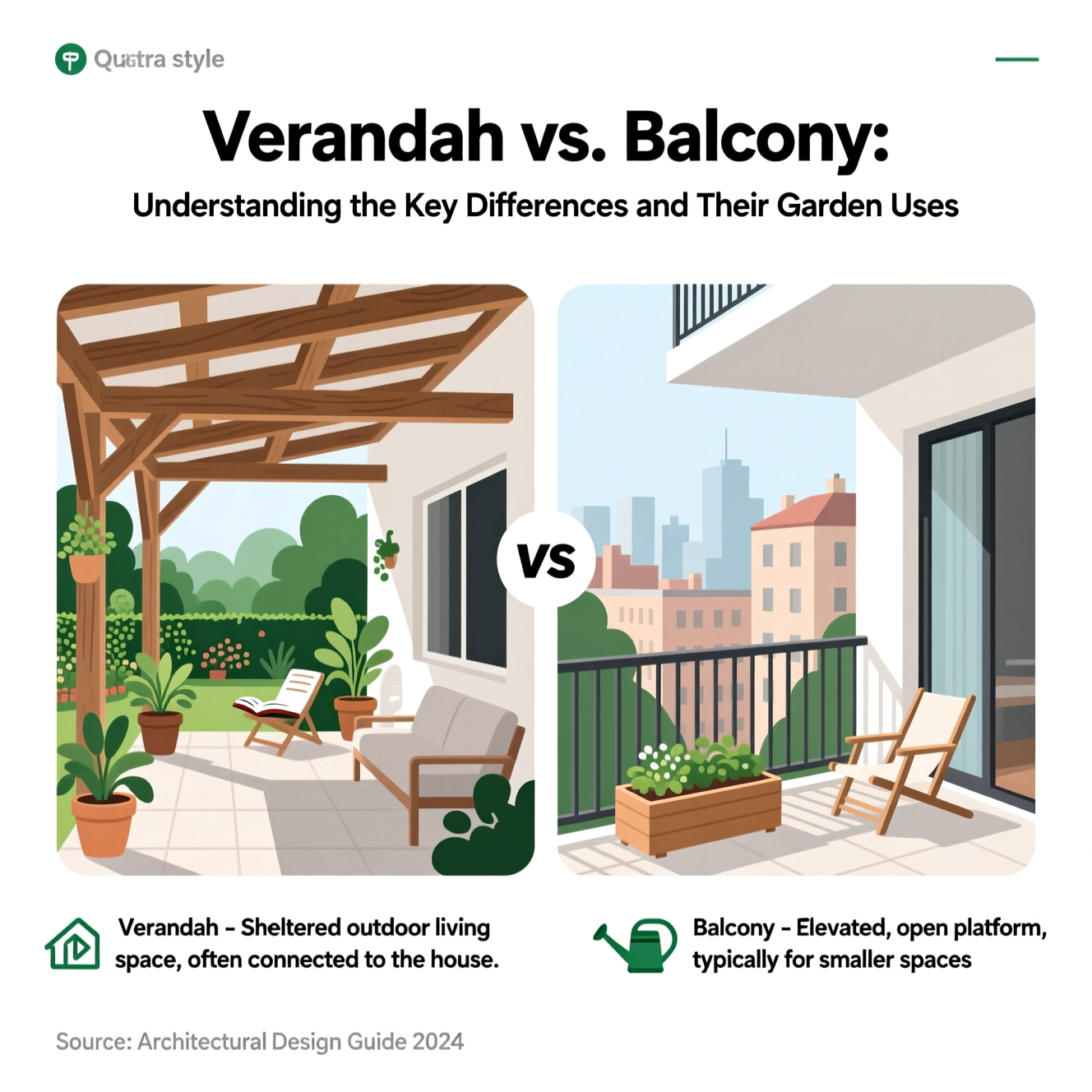What is the Fundamental Difference Between a Verandah and a Balcony?
The primary distinction between a verandah and a balcony lies in their location and structural integration. A verandah is fundamentally a ground-level, roofed structure. It often extends from the main building along one or more sides, serving as an architectural projection. For most homeowners, this creates an accessible outdoor room. This definition highlights its connection to the primary living space.
In contrast, a balcony is an elevated platform. It projects from an upper story of a building. Balconies are typically enclosed by a railing or balustrade for safety. While specific data varies by region, verandahs historically served as shaded gathering spaces, offering approximately 60-80% more usable ground-level outdoor space than a comparable balcony. This difference in footprint and elevation defines their distinct architectural roles.
The key architectural differences are clear. A verandah is a roofed structure directly accessible from the ground floor. A balcony is an elevated projection. This ensures clear understanding for differentiating these common outdoor features. Modern architectural practices consistently apply these definitions.
Is a Verandah Always Ground-Level and a Balcony Always Elevated?
Verandahs are intrinsically linked to the ground floor, providing direct access from the main living area. In contrast, balconies are extensions of an upper storey, accessed from a higher level. This primary access point is the defining characteristic, even as modern architectural trends sometimes blur distinctions. The verandah’s design ensures a seamless transition to the outdoors at ground level.
While typically ground-level, some slightly raised verandahs might exist, offering a minimal elevation but maintaining a ground-floor feel. This differs significantly from a balcony’s pronounced elevation. For instance, a raised verandah might feature a few steps, yet its connection remains with the primary ground floor access. Maintaining structural integrity is paramount for both, ensuring safe access regardless of elevation.
The key differentiator remains the access level. A verandah is fundamentally a ground-floor amenity, whereas a balcony is designed for upper-level enjoyment. While cantilevered elements can influence design, the fundamental relationship to the building’s primary floor dictates its classification. This clear distinction is vital for understanding architectural terminology and design intent.
How Do Verandahs and Balconies Differ in Their Connection to the House?
Verandahs and balconies offer distinct connections to a house, impacting architectural style and flow. A verandah typically extends from the ground floor, often providing a seamless transition from interior living spaces. This integration is achieved through widened doorways or expansive sliding doors, creating an open-plan ambiance. In contrast, balconies are elevated, protruding features accessed independently from internal rooms, serving as distinct outdoor platforms.
Verandahs are generally designed with significant structural support, integrating with the main home’s foundation and facade. This allows them to feel like a natural extension of the house. Balconies, while also requiring robust load-bearing capabilities, often appear more as an appended element rather than an intrinsic part of the home’s base. For most homeowners, the choice influences the perceived size and connectivity of their living areas. A well-designed verandah can effectively extend a home’s living area by up to 30% by blurring indoor-outdoor boundaries.
What are the Typical Structural and Design Features of a Verandah?
A verandah, often conceived as a roofed patio, is a sheltered outdoor space. Its fundamental verandah structure involves a substantial roof overhang. This expansive cover is typically supported by robust posts or columns. Modern design principles ensure these elements provide ample shade and weather protection, enhancing the usability of the outdoor area.
The verandah design frequently includes a solid, level floor. Common materials for this floor are a durable concrete slab or attractive timber decking. For enhanced safety and aesthetic integration, verandahs may also feature balustrades. These railings define the edges of the space. The roof pitch is often engineered for optimal rainwater runoff, commonly ranging from a 5-degree to a 15-degree slope.
What Are the Key Design Elements of a Balcony?
Balcony design centers on creating a safe, functional, and appealing elevated platform. Essential structural components include the floor material, often concrete slabs or specialized decking, and robust safety barriers like a railing or balustrade. These elements are crucial for preventing falls and ensuring user security. For most homeowners, the aesthetic appeal is enhanced by integrating these functional pieces seamlessly.
In terms of construction, balconies are frequently designed as cantilevered structures extending from a building. Alternatively, they may be supported by external brackets. Building codes mandate strict standards for balcony railings, ensuring they can withstand significant lateral forces. For instance, they must typically resist a load of 1.5 kN per meter. This emphasis on impact resistance and structural integrity underpins safe balcony design.
How Can a Verandah Be Optimized for Garden Enjoyment and Sustainable Living?
Optimize your verandah for a dual purpose: gardening and sustainable living. Incorporate vertical gardening systems, ideal for growing herbs and vegetables in limited spaces. This strategy maximizes yield, as vertical gardening can increase food production by up to 50% in small areas. Consider integrating rainwater harvesting from your roof for efficient irrigation. For most gardeners, selecting durable, recycled materials for furniture enhances sustainability.
Furthermore, explore permeable paving or gravel options beneath the verandah. This improves drainage, a key aspect of sustainable outdoor living. Modern best practices emphasize composting kitchen scraps to create nutrient-rich soil amendments. Utilizing edible plants throughout your design provides fresh produce and aesthetic appeal. These garden verandah ideas transform the space into a productive, eco-friendly retreat.
What Are the Best Gardening and Decor Ideas for a Balcony?
Balcony garden ideas and balcony decor transform small spaces into green oases. Embrace container gardening with lightweight planters, ideal for limited weight capacity. Consider railing boxes for an efficient use of space, perfect for flowers and herbs. Modern experts recommend selecting drought-tolerant plants and wind-resistant species to thrive in exposed conditions.
For most gardeners, choosing smart outdoor furniture for a balcony is key. Opt for multi-functional, weather-resistant pieces that enhance usability without overwhelming the area. Using a lightweight potting mix, often incorporating perlite or vermiculite, can significantly reduce container weight. This can lower the load by up to 40%, a critical factor for balcony structural integrity.
These small space gardening solutions focus on maximizing aesthetic appeal and plant health. Lightweight planters and smart decor choices ensure a functional and beautiful outdoor extension. In practical terms, this approach brings nature and style effectively to compact urban living.

Tyler Grant runs our Tools & DIY testing lab, putting pruners, hoses, drip kits, and raised-bed systems through real-garden use. He documents builds, timings, and durability to deliver honest pros/cons and clear recommendations across budgets. Tyler’s guides include safety callouts, maintenance checklists, and step photos you can follow in a weekend.

